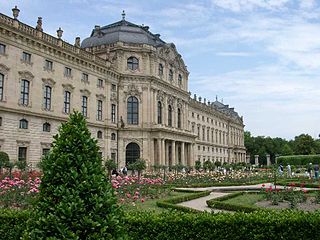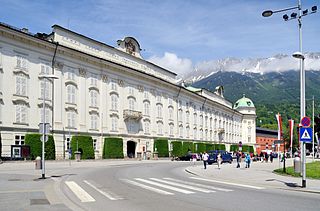| Schloss Haimhausen | |
|---|---|
| Haimhausen, Bavaria | |
 Schloss Haimhausen | |
| Coordinates | 48°18′47″N11°32′45″E / 48.313056°N 11.545833°E |
| Type | Schloss |
Schloss Haimhausen is a Schloss in the Bavarian town of Haimhausen, Germany.
| Schloss Haimhausen | |
|---|---|
| Haimhausen, Bavaria | |
 Schloss Haimhausen | |
| Coordinates | 48°18′47″N11°32′45″E / 48.313056°N 11.545833°E |
| Type | Schloss |
Schloss Haimhausen is a Schloss in the Bavarian town of Haimhausen, Germany.

The site has been the location of a castle since at least 1281, when it was mentioned in written sources. This first castle was however destroyed during the Thirty Years' War and not rebuilt until 1660. At that time, a Baroque palace was built on the site, the core of the present structure. It was rebuilt from 1747 to 1750 in a Rococo style, and has remained largely unchanged since. During this time, the estate belonged to Count Sigmund von Haimhausen, an industrialist, politician and co-founder of the Bavarian Academy of Sciences and Humanities who however died without heirs. After his death, the estate was sold to James Eduard Haniel. Descendants of Haniel still run a brewery located adjacent to the Schloss. The park of the estate was transformed into an English landscape garden during the ownership of Haniel. In 1794 it was sold again. It remained a family home until the 1930s, when the expensive upkeep of the buildings led to its abandonment as a home. [1] [2] During World War II, thousands of books from the Bavarian State Library were housed in the palace chapel. [1] After the war, the building has served several different purposes. It is today owned by the Bavarian International School. [1] The buildings are used for education and hence not open to the public. [2]
The appearance of the Schloss today is characterised by the reconstruction during the 18th century. The architect responsible for the rebuilding was François de Cuvilliés. He created the presently visible exterior and several of the interiors; during the reconstruction the house was also substantially enlarged. Among the interiors, the banqueting hall on the second floor, the so-called Golden Room and the chapel are especially noteworthy. The banqueting hall contains a ceiling painting depicting the four seasons, by Johann Georg Bergmüller, and two tile stoves from the Nymphenburg Porcelain Manufactory. Bergmüller also decorated the ceiling of the Golden Room, whose other decorations were designed by Cuvilliés. The chapel was decorated by both Bergmüller and Egid Verhelst and his sons. [1] [2] The building was restored during the 1980s and another renovation was carried out in 1997-1998. [1]

Neuschwanstein Castle is a 19th-century historicist palace on a rugged hill of the foothills of the Alps in the very south of Germany, just north of Austria. It is located in the Swabia region of Bavaria, in the municipality of Schwangau, above the incorporated village of Hohenschwangau, which is also the location of Hohenschwangau Castle. The closest larger town is Füssen. The castle stands above the narrow gorge of the Pöllat stream, east of the Alpsee and Schwansee lakes, close to the mouth of the Lech into Forggensee.


The Nymphenburg Palace is a Baroque palace situated in Munich's western district Neuhausen-Nymphenburg, in Bavaria, southern Germany. The Nymphenburg served as the main summer residence for the former rulers of Bavaria of the House of Wittelsbach. Combined with the adjacent Nymphenburg Palace Park it constitutes one of the premier royal palaces of Europe. Its frontal width of 632 m (2,073 ft) even surpasses Versailles Palace.

The Würzburg Residence is a palace in Würzburg, Germany. Johann Lukas von Hildebrandt and Maximilian von Welsch, representatives of the Austrian/South German Baroque style, were involved in the construction, as well as Robert de Cotte and Germain Boffrand, who were followers of the French Style. Balthasar Neumann, court architect of the Bishop of Würzburg, was the principal architect of the Residence, which was commissioned by the Prince-Bishop of Würzburg Johann Philipp Franz von Schönborn and his brother Friedrich Carl von Schönborn in 1720, and completed in 1744. The Venetian painter Giovanni Battista Tiepolo, assisted by his son, Domenico, painted frescoes in the building.

Solitude Palace is a Rococo schloss and hunting retreat commissioned by Charles Eugene, Duke of Württemberg. It was designed by Johann Friedrich Weyhing and Philippe de La Guêpière, and constructed from 1764 to 1769. It is located on an elongated ridge between the towns of Leonberg, Gerlingen and Stuttgart in Baden-Württemberg.

Allerton Castle, also known as Allerton Park, is a Grade I listed nineteenth-century Gothic or Victorian Gothic house at Allerton Mauleverer in North Yorkshire, England. It was rebuilt by architect George Martin, of Baker Street, London in 1843–53.

The Residenz in central Munich is the former royal palace of the Wittelsbach monarchs of Bavaria. The Residenz is the largest city palace in Germany and is today open to visitors for its architecture, room decorations, and displays from the former royal collections.

Schloss Charlottenburg is a Baroque palace in Berlin, located in Charlottenburg, a district of the Charlottenburg-Wilmersdorf borough.

Buda Castle is the historical castle and palace complex of the Hungarian Kings in Budapest. It was first completed in 1265, although the massive Baroque palace today occupying most of the site was built between 1749 and 1769. The complex in the past was referred to as either the Royal Palace or the Royal Castle. The castle now houses the Hungarian National Gallery and the Budapest Historical Museum.

The Schleißheim Palace comprises three individual palaces in a grand Baroque park in the village of Oberschleißheim, a suburb of Munich, Bavaria, Germany. The palace was a summer residence of the Bavarian rulers of the House of Wittelsbach.

Wallenstein Palace is a Baroque palace in Malá Strana, Prague, that served as a residence for Imperial Generalissimo Albrecht von Wallenstein and now houses the Senate of the Czech Republic.
François de Cuvilliés, sometimes referred to as the Elder, was a Belgian-born Bavarian decorative designer and architect. He was instrumental in bringing the Rococo style to the Wittelsbach court at Munich and to Central Europe in general.

Schloss Esterházy is a palace in Eisenstadt, Austria, the capital of the Burgenland state. It was constructed in the late 13th century, and came under ownership of the Hungarian Esterházy family in 1622. Under Paul I, 1st Prince Esterházy of Galántha the estate was converted into a baroque castle which remained the principal residence and center of administration of the family for over 300 years.

Haimhausen is a municipality located on the Amper River in the district of Dachau in Bavaria, Germany, about 20 kilometres north of Munich.

Slovenska Bistrica Castle, also known as Bistrica Castle, is a Renaissance-Baroque palace outside the town of Slovenska Bistrica in northeastern Slovenia. Its name derives from the Slovene word bistra 'clear'.

The Neuburg Castle is a palace in Neuburg an der Donau, Upper Bavaria.

Nikolaus Gromann was an architect of the German Renaissance who served at the court of John Frederick I, Elector of Saxony. He also worked for John Frederick's descendants residing in the cities of Weimar, Gotha and Altenburg, thus spending more than 30 years in the service of the House of Wettin.

The Hofburg is a former Habsburg palace in Innsbruck, Austria, and considered one of the three most significant cultural buildings in the country, along with the Hofburg Palace and Schönbrunn Palace in Vienna. The Hofburg is the main building of a large residential complex once used by the Habsburgs that still includes the Noblewomen's Collegiate Foundation, the Silver Chapel, the Hofkirche containing Emperor Maximilian's cenotaph and the Schwarzen Mandern, the Theological University, the Tyrolean Folk Art Museum, Innsbruck Cathedral, the Congress, and the Hofgarten.

Lembeck Castle, located in the urban area of Dorsten on the border of the northern Ruhr region and the southern Münsterland, is a moated castle. It is located in the Hohe Mark Nature Park and surrounded by the "Hagen" and "Kippheide" forests to the south of the Dorsten district of Lembeck in the northwest of the Recklinghausen region.

Reinbek Castle, located in Reinbek in southern Schleswig-Holstein, was built in the 16th century as a secondary residence for the ducal house of Schleswig-Holstein-Gottorf. It is one of the oldest buildings from the reign of Duke Adolf I and is regarded as the best example of the Renaissance style in Schleswig-Holstein. The castle was restored from 1977 to 1987 and now serves as an art and cultural center for the town of Reinbek.